Text

A letter from Sergeant William H. Carney acknowledging his receipt of the Congressional #MedalofHonor in 1900 for his actions in the assault on Fort Wagner in 1863.
#54th Massachusetts Regiment#54th Massachusetts#Civil War#African Americans#History#National Archives#Fort Wagner#RepresentedInTheArchives
76 notes
·
View notes
Photo
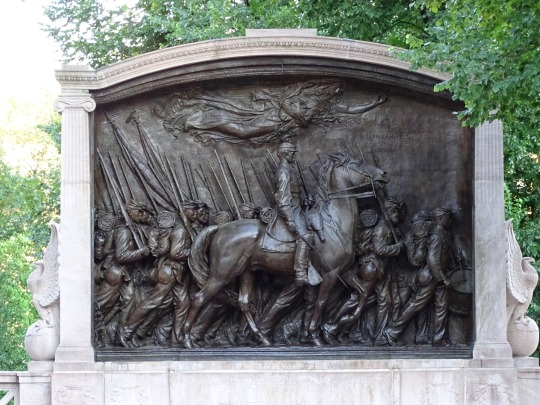
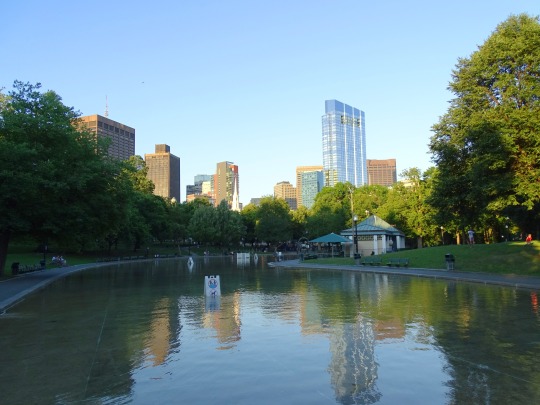
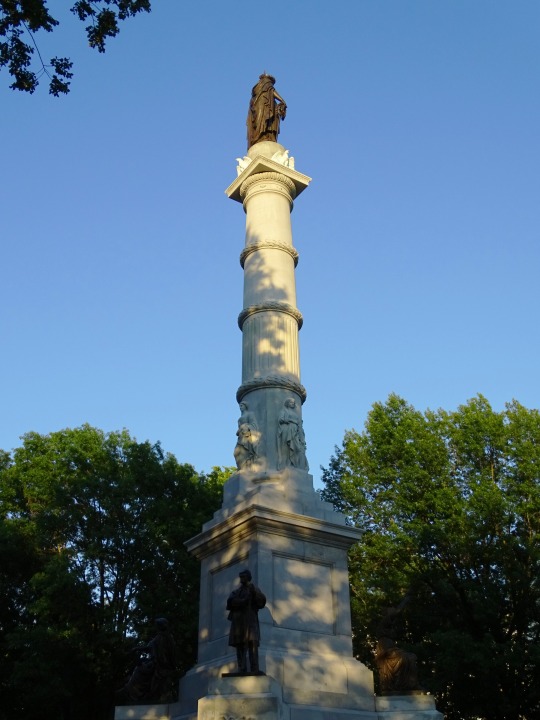
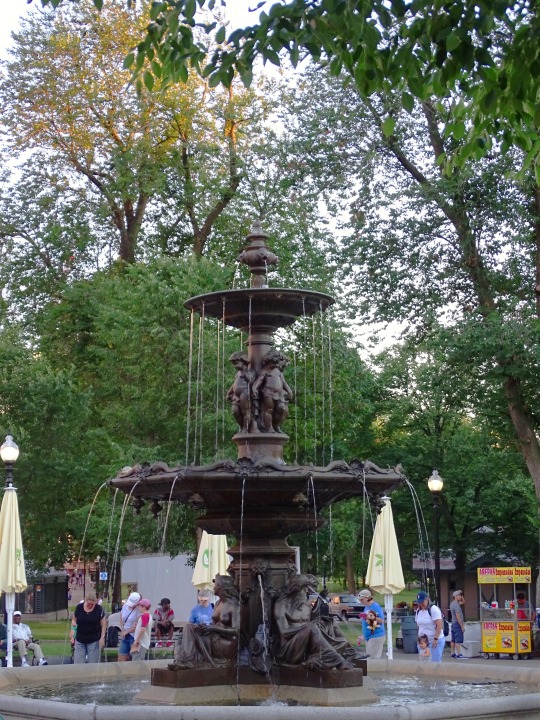

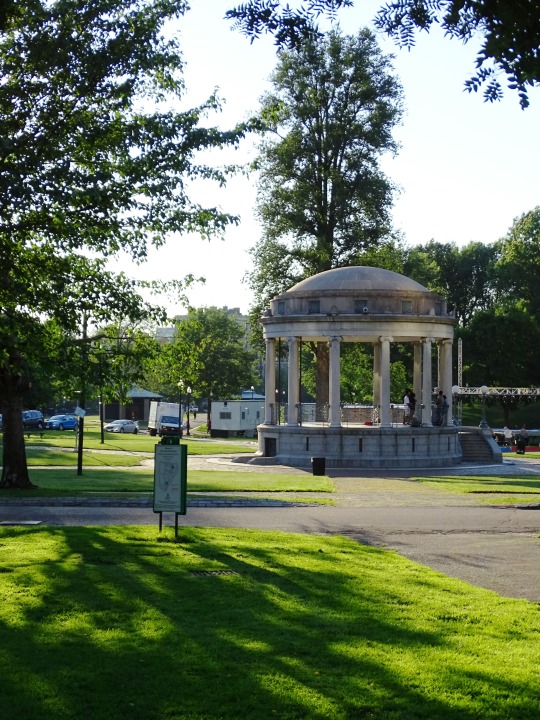


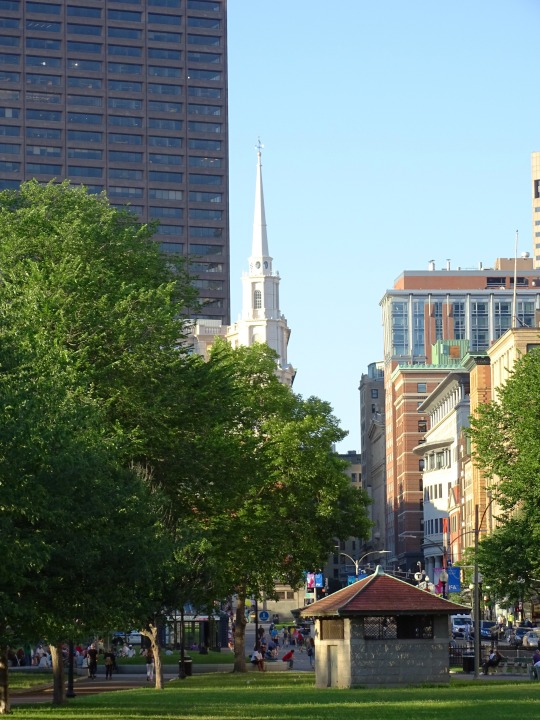
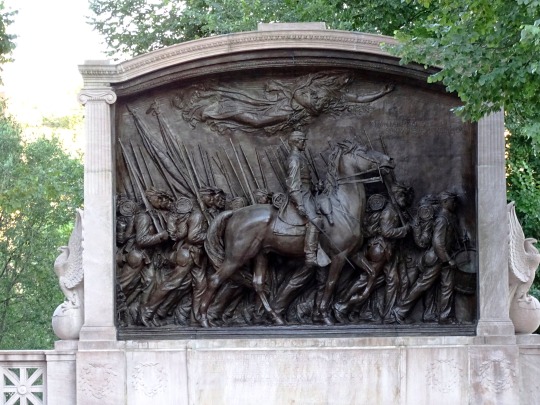
At nine o’clock on the morning on May 28, 1863, the 54th’s 1,007 black soldiers and 37 white officers gathered in the Boston Common and prepared to head to the battlefields of the South. That evening, the 54th Infantry boarded a transport ship bound for Charleston.
#Shaw Memorial by Augustus Saint-Gaudens#Boston Common#Massachusetts#Memorial to Robert Gould Shaw and the Massachusetts Fifty-Fourth Regiment#Soldiers and Sailors Monument by Martin Milmore#Brewer Fountain#Boston#Parkman Bandstand#Mine Sweepers Memorial mit Mark VI mine#54th Infantry#transport#28 May 1863#US history#160th anniversary#summer 2018#USA#cityscape#tourist attraction#US Civil War#American Civil War:#landmark
15 notes
·
View notes
Text
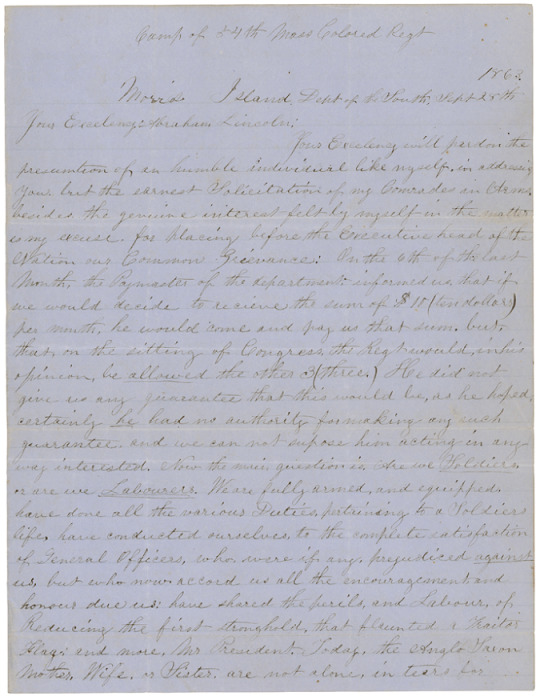
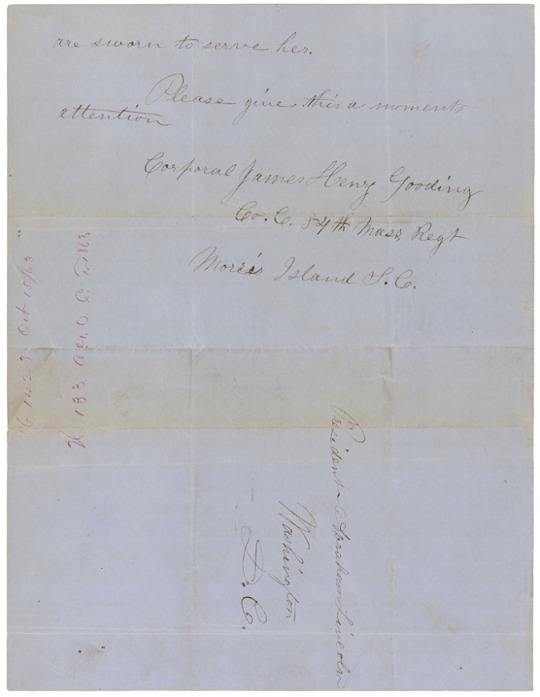
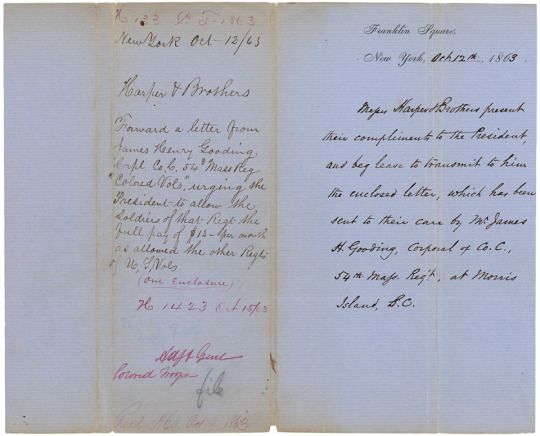
Letter from Corporal James Henry Gooding to the President
Record Group 94: Records of the Adjutant General's OfficeSeries: Letters ReceivedFile Unit: Consolidated File for Corporal James H. Gooding, 54th Massachusetts Infantry Regiment (Colored)
The item is a letter written by Corporal James Henry Gooding of the 54th Regiment of Massachusetts Infantry to President Abraham Lincoln.
Camp of 54th Mass Colored Regt 1863 Moria Island Dept of South . Sept 28th Your Excellency : Abraham Lincoln: Your Excellency will pardon the presumtion of an humble individual like myself in addressing your but the earnest Solicitation of my Comrades in Arms besides the genuine interest felt by myself in the matter is my excuse. for placing before the Executive head of the Nation our Common Grievance: On the 6th of the last Month, the Payments of the department informed us that if we would decide to recieve the sum of $10 (ten dollars) per month he would come and pay us that sum. but that, in the sitting of Congress the Regt would in his opinion be [underline] allowed [/underline] the other 3 (three) He did not give us any guarantee that this would be as he hoped certainly [underline] he [/underline] had no authority for making any such guarantee and we can not supose him acting in anyway interested . Now the main question is Are we [underline] Soldiers [/underline] or are we [underline] Labourers [/underline] We are fully armed and equipped have done all the various Duties. pertaining to a Soldiers life, have conducted ourselves to the complete satisfaction of General Officers, who were if any prejudiced [underline] against [/underline] us but who now accord us all the encouragement and honour due us: have shared the perils and Labour of Reducing the first stronghold that flaunted a Traitor Flags and more. Mr Prresident Today the Anglo Saxon Mother. Wife.or Sister are not alone in tears for [thoare sworn to serve her. Please give this a moments attention. Corporal James Henry Gooding Co. C. 54th Mass. Regt. Morris Island, S. C. [addressed to] President Abraham Lincoln Washington D. C.
[bifold paper] [left hand side; handwritten] H 133 C. T. 1863 [red ink] New York Oct 12/63 Harper & Brothers Forward a letter from James Henry Gooding Corpl. Co. C. 54th Mass Reg "Colored Vols", urging the President to allow the Soldiers of that Regt. the full pay of $13- per month as allowed the other Regts of U. S. Vols. (one enclosure) [red ink] H 1423 Oct 15/63 [red ink] Staff Genl Colored Troops- [red ink] file [pencil] Read AGO Oct 19, 1863 [red ink] [right side of paper handwritten except for letterhead] Franklin Square, New York, Oct 12, 1863 Messers Harper & Brothers present their compliments to the President, and beg leave to transmit to him the enclosed letter, which has been sent to their care by M. James H. Gooding, Corporal of Co. C., 54th Mass. Reg't., at Morris Island, S. C.
24 notes
·
View notes
Text

"Juneteenth is much larger than me; I'm just a small part of it, and I appreciate people's thanking me about designing the flag, which represents something much larger than itself. It's a flag about humanity. It's a flag about people who accomplished a lot, even though they went through a lot. It means an awakening."
Meet "Boston Ben" Haith, artist, activist, community organizer, and original designer of the Juneteenth flag. Born in 1942 Connecticut, Haith graduated from Stamford and travelled first to Ohio and then to Los Angeles. A short stint in the U.S. Army led him to Europe and then to New York, but he ultimately settled in Boston, where he not only married and raised a family, but also opened an advertising agency and became a community activist.
Naming the Blizzard of '78 as his starting point, Haith was incensed by the city's unannounced dumping of snow in a park in his neighborhood, and organized neighbors and other locals to raise formal objections. From there his talents found their way into community anti-crime initiatives and he became an outspoken critic of overreaching law enforcement. He ran for office in 1983 and again in 1985 for a seat on the City Council (District 7, a primarily Black constituency); and also as an advocate for the elderly, and also as a case manager at the New England Center for Homeless Veterans.
As a thought-provoking contrast --and perhaps doubly important to note in that Juneteenth also takes place during Pride Month-- Haith is also on record as having (at least, at one time) been staunchly opposed to any form of legalized same-sex relationships. In 1983 he published several editorials criticizing a gay couple who were operating a foster home in Roxbury; drawing sufficient attention in the press that then-governor Michael Dukakis intervened and removed two children from the home. Such was the intensity of Haith's op-ed pieces that the Roxbury Highlands Neighborhood Association took steps to distance themselves from him. In more recent years Haith's position on same-sex marriage would appear to have shifted somewhat; in a 2022 interview he opined that "Sometimes you've got to get out of the way of it, so that's what I've done. I'm not in the way of any group of people trying to improve their lives. I'm trying to improve the lives of people impacted by violence, that's primarily what my interest is right now. When you move on in life, things change, so maybe I've become more philosophical than I used to be."
In 1997, while still living in Boston, Haith came up with the original design of the Juneteenth flag --which would later be tweaked and adjusted by illustrator Lisa Jeanne Graf. Featuring a Lone Star at its center (representing Texas, the very last state to formally end slavery), the flag's color scheme favors the familiar red, white, and blue, but also incorporates an added "nova" effect, symbolizing a new day of freedom. Haith was present when the flag was first flown in 2000, at Boston's Roxbury Heritage State Park --in a ceremony featuring performers dressed in period costume as Harriet Tubman and the Colored Ladies of the 54th Regiment (Massachusetts Glory Brigade). In 2007 Graf added the significant date of June 19, 1865 to the flag's design. Both Haith and Graf are founding members of the National Juneteenth Celebration Foundation.
#blm#black lives matter#black history#pride#lgbtq+#juneteenth#intersectionality#roxbury#teachtruth#dothework
3 notes
·
View notes
Text
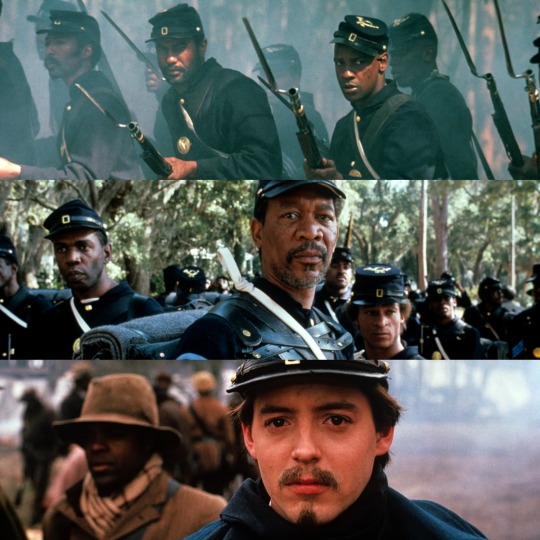
Glory (1989, Edward Zwick)
24/01/2024
Glory is a 1989 film directed by Edward Zwick about the first volunteer fighter unit formed by African Americans in the United Army during the American Civil War.
The film is inspired by the personal letters of Colonel Robert Gould Shaw, who led the 54th Massachusetts Volunteer Infantry Regiment from its formation in February 1863 until the attack on Fort Wagner in South Carolina, where he died during the assault in July of the same year.
Among the awards received, the film received five nominations for the 1990 Oscars, winning three as best supporting actor for Denzel Washington, best cinematography and best sound.
On September 17, 1862, during the American Civil War, Captain Robert Gould Shaw was slightly wounded during the Battle of Antietam and returned home to Boston on medical leave. During a ceremony in November of the same year, he met the abolitionist Frederick Douglass and at the request of Governor John Andrew, accepted the task of training and commanding with the rank of colonel the first regiment of African-American men of the Union Army.
The men are informed that due to President Lincoln's Emancipation Proclamation, the Confederacy has declared that all captured black Union soldiers will be returned to slavery and the white officers under their command shot.
In the subsequent clashes, the regiment gained the valor and respect of the white soldier and Shaw proposed himself to General George Strong as the first attack force on Fort Wagner, as part of the campaign to secure the port city of Charleston.
The officers are aware that breaking the fort's defenses will not be easy; in fact the fortress had previously been attack by a white regiment but without success (First Battle of Fort Wagner). A front-line force of the 54th, with supporting white companies, begins the Second Battle of Fort Wagner.
The film budget was $18 million and filming took place in Georgia and Massachusetts from February 9 to April 27, 1989.
Rotten Tomatoes indicates that 93% of 40 selected critics gave the film a positive review, with an average score of 7.9 out of 10.
#glory#film#1989#edward zwick#union#american civil war#Robert Gould Shaw#1863#south carolina#62nd Academy Awards#denzel washington#1862#Captain#Battle of Antietam#Boston#frederick douglass#John Albion Andrew#Military rank#Colonel#union army#emancipation proclamation#abraham lincoln#confederate states of america#George Strong#charleston south carolina#First Battle of Fort Wagner#Second Battle of Fort Wagner#georgia#massachusetts#rotten tomatoes
6 notes
·
View notes
Note
movie recs? movie recs please?
I have to be so honest with you when I say I don't have a particularly good or smart taste in movies, so like.... I'm going to give you 3 of my favorite movies. Clicking the titles should direct you to their respective doesthedogdie . com pages for lists of potential triggers.
• Spirit: Stallion of the Cimarron
Rated G, released in 2002
Set in the Old West in the late 19th century, the film follows Spirit, a mustang stallion, who is captured during the American Indian Wars by the United States Cavalry; he is eventually freed by a Lakota man named Little Creek with whom he bonds, as well as a mare named Rain.

• The Princess Bride
Rated PG, released in 1987
Adapted by William Goldman from his 1973 novel of the same name, it tells the story of a swashbuckling farmhand named Westley, accompanied by companions befriended along the way, who must rescue his true love Princess Buttercup from the odious Prince Humperdinck.

• Glory
Rated R, released in 1989 (Please review the trigger warnings with this movie.)
Glory is a 1989 American historical war drama film directed by Edward Zwick about the 54th Massachusetts Infantry Regiment, one of the Union Army's earliest African-American regiments in the American Civil War. It stars Matthew Broderick as Colonel Robert Gould Shaw, the regiment's commanding officer, and Denzel Washington, Cary Elwes, and Morgan Freeman as fictional members of the 54th.The film depicts the soldiers of the 54th from the formation of their regiment to their heroic actions at the Second Battle of Fort Wagner.
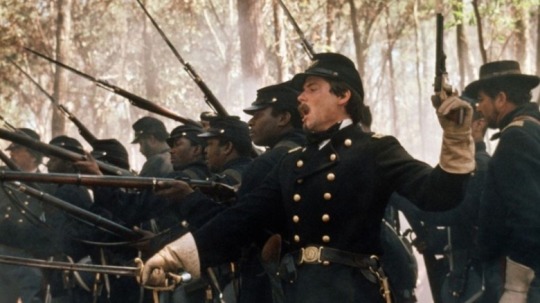
#i know these are basically not anything like one another I'm sorry#but um..... three different ratings to choose from#i appreciate this ask thank you#but seriously with glory- review the triggers#i highly recommend the movie it's something i think everyone should watch at least once but#it covers very serious topics like war + slavery + racism#there are racial slurs used in the film and graphic depictions of violence and (brief) gore
3 notes
·
View notes
Text
Events 7.18 (before 1950)
477 BC – Battle of the Cremera as part of the Roman–Etruscan Wars. Veii ambushes and defeats the Roman army. 387 BC – Roman-Gaulish Wars: Battle of the Allia: A Roman army is defeated by raiding Gauls, leading to the subsequent sacking of Rome. 362 – Roman–Persian Wars: Emperor Julian arrives at Antioch with a Roman expeditionary force (60,000 men) and stays there for nine months to launch a campaign against the Persian Empire. 452 – Sack of Aquileia: After an earlier defeat on the Catalaunian Plains, Attila lays siege to the metropolis of Aquileia and eventually destroys it. 645 – Chinese forces under general Li Shiji besiege the strategic fortress city of Anshi (Liaoning) during the Goguryeo–Tang War. 1195 – Battle of Alarcos: Almohad forces defeat the Castilian army of Alfonso VIII and force its retreat to Toledo. 1290 – King Edward I of England issues the Edict of Expulsion, banishing all Jews (numbering about 16,000) from England. 1334 – The bishop of Florence blesses the first foundation stone for the new campanile (bell tower) of the Florence Cathedral, designed by the artist Giotto di Bondone. 1389 – France and England agree to the Truce of Leulinghem, inaugurating a 13-year peace, the longest period of sustained peace during the Hundred Years' War. 1507 – In Brussels, Prince Charles I is crowned Duke of Burgundy and Count of Flanders, a year after inheriting the title. 1555 – The College of Arms is reincorporated by Royal charter signed by Queen Mary I of England and King Philip II of Spain. 1723 – Johann Sebastian Bach leads the first performance of his cantata Erforsche mich, Gott, und erfahre mein Herz, BWV 136, in Leipzig on the eighth Sunday after Trinity. 1806 – A gunpowder magazine explosion in Birgu, Malta, kills around 200 people. 1812 – The Treaties of Orebro end both the Anglo-Russian and Anglo-Swedish Wars. 1841 – Coronation of Emperor Pedro II of Brazil. 1857 – Louis Faidherbe, French governor of Senegal, arrives to relieve French forces at Kayes, effectively ending El Hajj Umar Tall's war against the French. 1862 – First ascent of Dent Blanche, one of the highest summits in the Alps. 1863 – American Civil War: Second Battle of Fort Wagner: One of the first formal African American military units, the 54th Massachusetts Volunteer Infantry, supported by several white regiments, attempts an unsuccessful assault on Confederate-held Battery Wagner. 1870 – The First Vatican Council decrees the dogma of papal infallibility. 1872 – The Ballot Act 1872 in the United Kingdom introduced the requirement that parliamentary and local government elections be held by secret ballot. 1914 – The U.S. Congress forms the Aviation Section, U.S. Signal Corps, giving official status to aircraft within the U.S. Army for the first time. 1925 – Adolf Hitler publishes Mein Kampf. 1942 – World War II: During the Beisfjord massacre in Norway, 15 Norwegian paramilitary guards help members of the SS to kill 288 political prisoners from Yugoslavia. 1942 – The Germans test fly the Messerschmitt Me 262 using its jet engines for the first time. 1944 – World War II: Hideki Tōjō resigns as Prime Minister of Japan because of numerous setbacks in the war effort.
1 note
·
View note
Text
youtube
Andre Braugher in a scene from Glory (1989)
In his first role in a feature film, the late Andre Braugher left a hell of an impression - one year after his graduation from Juilliard for drama.
Glory, directed by Edward Zwick, tells the story of the 54th Massachusetts Infantry Regiment - the Union army's first all-black unit in the midst of the American Civil War. It is told mostly through the lens of Capt. Robert Gould Shaw (Matthew Broderick), the white commanding officer of the 54th. Braugher plays Thomas Searles, a freedman who was Shaw's former secretary and enlisted shortly after hearing of the creation of the 54th.
Searles eventually learns the martial technique demonstrated in this scene and executes it to perfection during the film's climactic battle.
#Andre Braugher#Glory#Edward Zwick#John Finn#Denzel Washington#Matthew Broderick#Cary Elwes#Jihmi Kennedy#Morgan Freeman#most of us on tumblr learned of Braugher on B99... this was my introduction to him
2 notes
·
View notes
Text
On Memorial Day 2022, we take a look at the African American origins of the federal holiday established to remember America’s fallen soldiers.
Although May 30, 1868 is cited as the first national commemoration of Memorial Day at Arlington National Cemetery, events lead by African Americans in Charleston, South Carolina to decorate the graves of fallen Civil War soldiers occurred on May 1, 1865, less than a month after the Confederacy surrendered.
Reports of this early version of Memorial Day or “Decoration Day” as it was called, were rediscovered in the Harvard University archives in the late 1990s by historian David Blight, author of the 2018 biography Frederick Douglass: Prophet of Freedom.
To quote from history.com:
When Charleston fell and Confederate troops evacuated the badly damaged city, those freed from enslavement remained. One of the first things those emancipated men and women did was to give the fallen Union prisoners a proper burial. They exhumed the mass grave and reinterred the bodies in a new cemetery with a tall, whitewashed fence inscribed with the words: “Martyrs of the Race Course.” And then on May 1, 1865, something even more extraordinary happened. According to two reports that Blight found in The New York Tribune and The Charleston Courier, a crowd of 10,000 people, mostly freed slaves with some white missionaries, staged a parade around the race track. Three thousand Black schoolchildren carried bouquets of flowers and sang “John Brown’s Body.” Members of the famed 54th Massachusetts and other Black Union regiments were in attendance and performed double-time marches. Black ministers recited verses from the Bible. Despite the size of the gathering and newspaper coverage, the memory of this event was “suppressed by white Charlestonians in favor of their own version of the day,” Blight stated in the New York Times in 2011.
On May 31, 2010, near a reflecting pool at Hampton Park, the city of Charleston reclaimed this history by installing a plaque commemorating the site as the place where Blacks held the first Memorial Day on May 1, 1865.
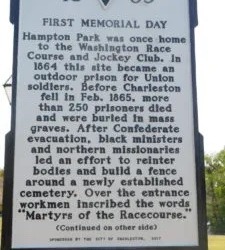
During the dedication of the plaque, the city’s mayor at the time, Joe Riley, was present to celebrate the historic occasion which included a brass band and a reenactment of the Massachusetts 54th Regiment.
In 2017, the City of Charleston erected yet another sign reclaiming the history and commemorating the event:
“On May 1, 1865 a parade to honor the Union war dead took place here. The event marked the earliest celebration of what became known as “Memorial Day.” The crowd numbered in the thousands, with African American school children from newly formed Freedmen’s Schools leading the parade. They were followed by church leaders, Freedpeople, Unionists, and members of the 54th Massachusetts 34th and 104th U.S. Colored Infantries. The dead were later reinterred in Beaufort.”
To learn more about African Americans’ role in the creation of Memorial Day, check out the links to sources provided in today’s show notes and in the episode’s full transcript posted on goodblacknews.org.
This has been a daily drop of Good Black News, written, produced and hosted by me, Lori Lakin Hutcherson.
For more Good Black News, check out goodblacknews.org or search and follow @goodblacknews anywhere on social.
Sources:
https://www.history.com/news/memorial-day-civil-war-slavery-charleston
https://www.lx.com/black-legacy/dont-overlook-memorial-days-black-southern-roots/53453/
https://www.live5news.com/2020/02/18/charleston-claims-first-memorial-day-celebration-with-african-americans-playing-significant-role/
https://amsterdamnews.com/news/2022/05/28/freed-slaves-started-first-memorial-day-in-the-us/
https://aaregistry.org/story/the-first-american-memorial-day-is-commemorated/
https://www.harlemworldmagazine.com/memorial-day-african-americans-memorial-day-charleston-south-carolina-1865/
#How “Decoration Day” in May 1865#Held by African Americans in South Carolina Led to Memorial Day#freedmen#Black Families#reconstruction#Beaufort S.C.memorial day#memorial day
5 notes
·
View notes
Photo

(The far more detailed version of this is on FB) Good afternoon, folks. It's time for another New York Harbor Defense Happy Birthday! We would like to honor the 181st Birthday of Colonel Charles James Mills, who was born today on (Fri) Jan 8th, 1841 in Boston, MA. (Pic 1) Charles graduated from Harvard in 1840, before attending the precursor to the Massachusetts Institute of Technology, with a study in Engineering. When the Civil War broke out in 1861, he immediately made an effort to join the service as an Officer. August 14th, 1862, age 21, he found himself as a Second Lieutenant in Company I of the 2nd Massachusetts Infantry Regiment, part of the 3rd Brigade, 1st Division, 2nd Corps. One of his fellow officers in the Regiment was 25 year old Robert Gould Shaw who would go on to command the 54th Massachusetts Volunteer Infantry (Colored). Both men were wounded at Antietam a month later. Sent home, Mills was medically discharged before joining the 56th MA Infantry. He served at the Wilderness, Spotsylvania, Bethesda Church, and Petersburg. On the staff of Major General Andrew A. Humphreys, the 2nd Corps Commander, he was made Brevet Colonel on Mar 30th 1865. The next day, he was killed at the Battle Of Hatcher's Run, VA 10 days before the war ended on April 9th. He was 24. Brought home, he was laid to rest in Jamaica Plain, MA. (Pic 2). At Ft Wadsworth on Staten Island, NY a new 6-inch disappearing battery was built in 1900 and named in his honor in 1906. Oriented south, the guns covered the harbor approaches. It served in the defenses of the harbor through 1943. Regrettably, Battery Mills is all but forgotten today, nearly completely buried in the postwar years, and heavily overgrown, neglected, and permanently abandoned by the National Park Service. The Battery may be vanishing, but we will never, ever let the legacy of Colonel Charles James Mills be forgotten. 🇺🇲🇺🇲 ** Please Like & Follow "Sandy Hook History" on Facebook & Instagram for more amazing maritime and military histories of the Garden State and New York Harbor as well as a review of the 80th Anniversary of the Battle Of The Atlantic and World War 2** 🇺🇲🇺🇲 (at Fort Hancock, New Jersey) https://www.instagram.com/p/CnK2QWMAYrn/?igshid=NGJjMDIxMWI=
4 notes
·
View notes
Text
Valor Unbound: The Legacy of the 54th Massachusetts Infantry Regiment

Happy Black History Month!
This week, we are highlighting the honor and bravery of the 54th Massachusetts Infantry Regiment, one of the first African American units in the Civil War. Established in 1863, following the Emancipation Proclamation, the formation of the regiment marked a pivotal moment in military history, challenging racial barriers and setting a precedent for the inclusion of African Americans in the United States military.
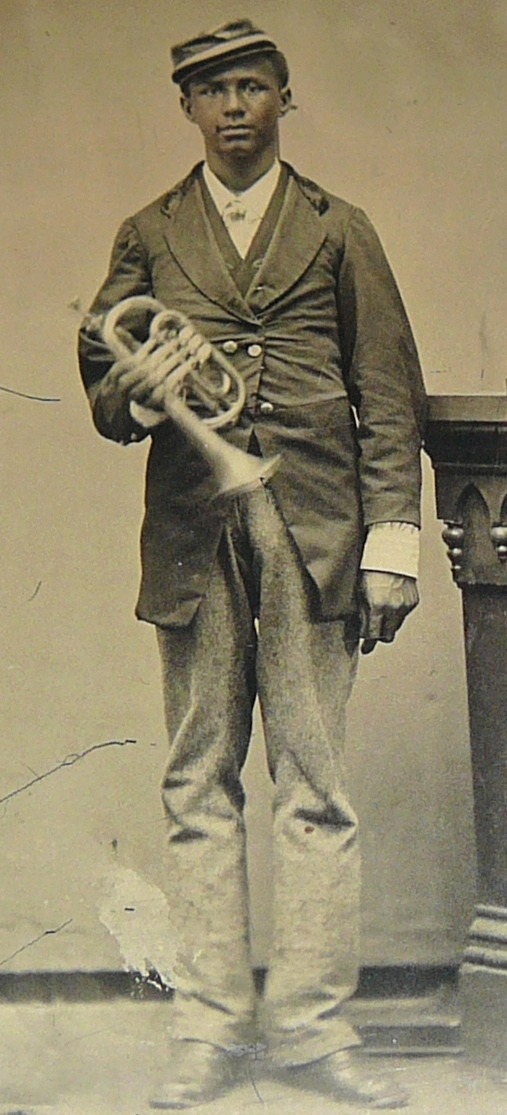

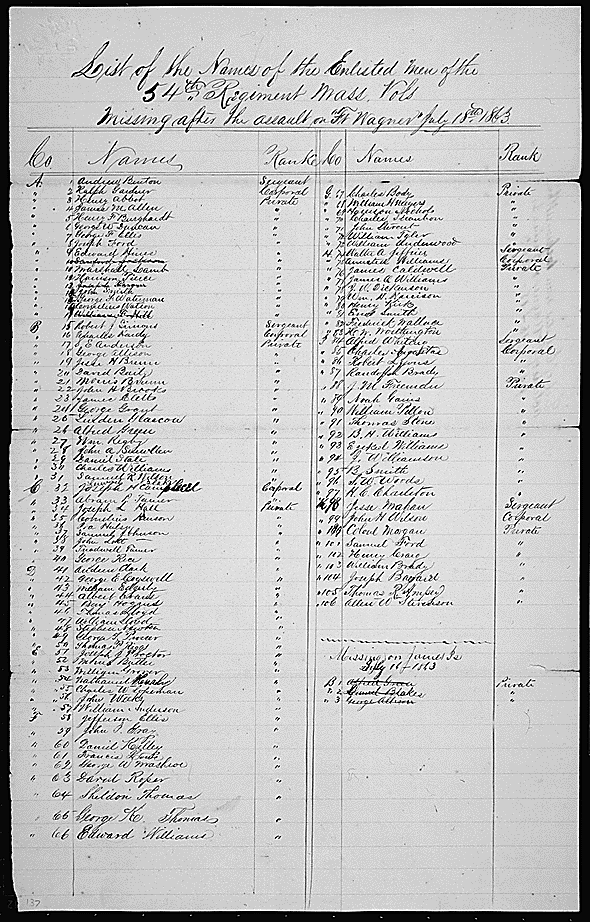
Under the leadership of Colonel Robert Gould Shaw, the 54th Massachusetts consisted of free African American men and escaped slaves eager to fight for the Union and the freedom of their fellow Americans. Their most notable engagement, at Fort Wagner, South Carolina, showcased their courage and determination. Though the battle was fierce and the regiment suffered heavy casualties, their sacrifice significantly bolstered the Union’s morale and support for African American soldiers.

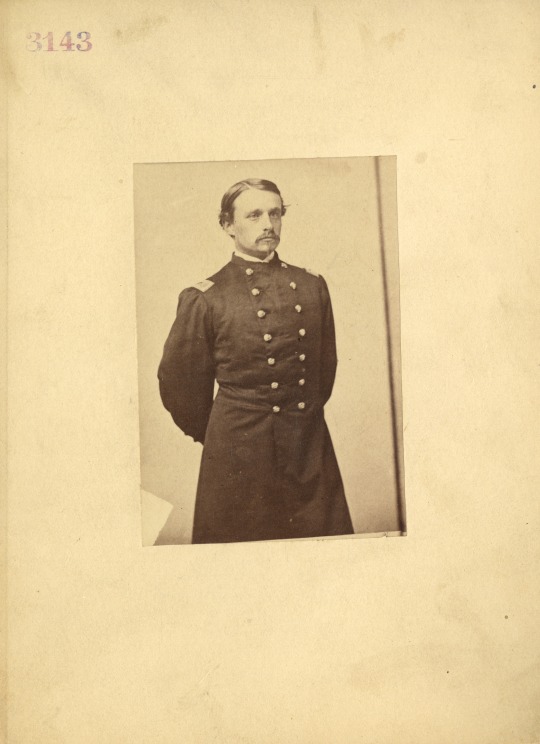
The legacy of the 54th Massachusetts Infantry Regiment extends beyond their military achievements. By demonstrating the valor and capability of African American soldiers, they helped change public opinion and policies, leading to the enlistment of nearly 200,000 African American men in the Union forces by the war’s end.
Additional resources:
https://www.archives.gov/exhibits/american_originals/54thmass.html
https://prologue.blogs.archives.gov/2018/02/01/black-history-month-the-54th-massachusetts/
https://www.archives.gov/education/lessons/blacks-civil-war/compiled-service-records.html
https://www.archives.gov/education/lessons/blacks-civil-war/douglass-sons.html
https://prologue.blogs.archives.gov/2021/07/09/facial-hair-friday-robert-gould-shaw/
https://docsteach.org/documents/document/casualty-list-54th-massachusetts-assault-on-fort-wagner
https://www.archives.gov/research/african-americans
#Black History Month#African American History#Veterans#Military History#National Archives#54th Massachusetts Infantry
113 notes
·
View notes
Text









At nine o’clock on the morning on May 28, 1863, the 54th’s 1,007 black soldiers and 37 white officers gathered in the Boston Common and prepared to head to the battlefields of the South. That evening, the 54th Infantry boarded a transport ship bound for Charleston.
#Shaw Memorial by Augustus Saint-Gaudens#Boston Common#Massachusetts#Memorial to Robert Gould Shaw and the Massachusetts Fifty-Fourth Regiment#Soldiers and Sailors Monument by Martin Milmore#Brewer Fountain#Boston#Parkman Bandstand#Mine Sweepers Memorial mit Mark VI mine#54th Infantry#transport#28 May 1863#US history#anniversary#summer 2018#USA#cityscape#tourist attraction#US Civil War#American Civil War:#landmark#original photography#travel#vacation#architecture
1 note
·
View note
Photo

UNIT PROFILE – 54TH MASSACHUSETTS VOLUNTEER INFANTRY REGIMENT The Emancipation Proclamation’s promulgation in 1863 opened the Union Army’s ranks to Black soldiers for the first time, allowing Black Americans to fight for the Union’s preservation and the end of slavery. The 54th Massachusetts Volunteer Infantry Regiment was among the first all-Black units to be stood up. Led by COL Robert Gould Shaw (scion of a prominent abolitionist family) and promoted by prominent figures like Frederick Douglass, the 54th was flooded with recruits. Despite Confederate promises to punish captured Black soldiers and their white officers with summary execution for promoting “servile insurrection,” the 54th marched to war in high spirits, leaving Boston on 28 MAY. From 18 – 19 JUL the Union began operations to capture Fort Wagner (a critical part of the harbor defenses of Charleston, South Carolina) following an early unsuccessful attack from 10 – 11 JUL. Deploying a force of 5,000 infantry in a frontal assault, the Union placed the 54th in the vanguard of the attack force, sending them charging across an open field towards Ft. Wagner under withering rifle and artillery fire rained on them by the 1,800 Confederate defenders. COL Shaw led the 54th up the fortifications, rallying his men with a cry of “Forward Fifty-Fourth!” from atop the ramparts before being killed. Despite their commander’s death the 54th pushed on, engaging the rebels in bitter hand-to-hand fighting. Despite 54th’s best efforts, the Union was unable to break through the fort’s defenses; the 54th paid an exorbitant price for its extraordinary valor, suffering a staggering 42% casualty rate (280 of the 600 of its men who fought in the Second Battle of Ft. Wagner). The stories of the 54th’s heroism quickly spread across the Union, motivating Black Americans to enlist in the U.S. Army. Between 1863 and 1865 nearly 200,000 Black soldiers served the cause of liberty, contributing roughly 10% of the U.S. Army’s Civil War manpower. #Armyhistory #USArmy #TRADOC #CivilWar #CivilWarHistory #ArmyHeritage #MilitaryHistory #BlackHistoryMonth #54thmassachusetts Posted @withregram • @armyhistory (at Army Recruiting Columbia, TN) https://www.instagram.com/p/CocK6HVutK2/?igshid=NGJjMDIxMWI=
#armyhistory#usarmy#tradoc#civilwar#civilwarhistory#armyheritage#militaryhistory#blackhistorymonth#54thmassachusetts
1 note
·
View note
Text

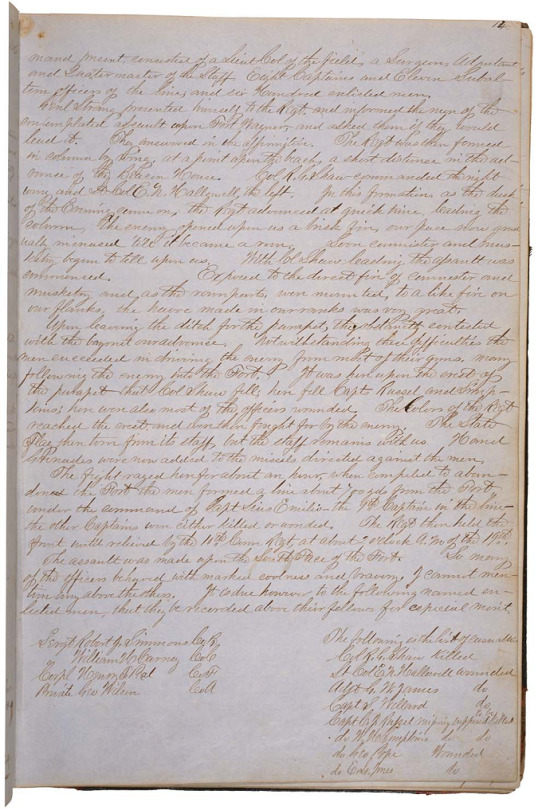

Letter from Colonel Edward Hallowell to General Truman Seymour
Record Group 94: Records of the Adjutant General's OfficeSeries: Regimental and Company Books of Civil War Volunteer Union OrganizationsFile Unit: Regimental and Company Books of the 54th Massachusetts Infantry Regiment (Colored)
This item is a copy of a letter sent by Colonel Edward N. Hallowell to General Truman Seymour concerning the assault on Fort Wagner, South Carolina. It is located in the volume of letters sent by the 54th Regiment of Massachusetts Infantry.
[page number] 13 Head Quarters 54th Regt Mass Vols Morris Island S. C. Nov 7th 1863 To His Excellency John A. Andrew Governor. As yet no official information has been received in regard to the fate of Capts Russel and Simpkins, and we are obliged to drop their names from the rolls. Therefore respectfully suggest the following promotions and appointments. Major Henry W. Hooper. To be Lt. Col. vice E. W. Hallowell promoted Capt George Pope to be Major vice H. W. Hooper promoted 1st Lieut James L. Higgman to be Captain vice C. J. Russel missing in action since July 18th 1863 1st Lieut R. H. L. Jewelt to be Captain vice W. H. Simpkins missing in action since July 18th 1863 1st Lieut James W. Grace to be Captain vice George Pope promoted 2d Lieut David Reid to be 1st Lieut vice J. L. Higgman promoted 2d Lieut Edward B Enurein to be 1st Lieut vice R. H. L. Jewett promoted 2d Lieut Ezekiel Gaulbert Tomlinson to be 1st Lieut. vice James W. Grace, promoted Sergt Daniel G. Spears of 24th Regt Mass to be 2d Lieut, vice David Reid promoted Charles W Duren of 24th Mass to be 2d Lieut vice E. B. Emerson promoted Commission for Mr Dunn to be sent to care of Brig Genl T. G. Stevenson I prefer not to make any other appointments until I learn more of the character of the applicants Very Respectfully E. W. Hallowell Col 54th Mass Vols Head Quarters 54th Mass Vols Morris Island S. C. Nov 7th 1863 Brig Genl. T. Seymour Comd'g U. S. Forces Morris S. C. Genl, In answer to your request that I furnish a report of the part taken by the 54th Mass Vols in the late assault upon Fort Wagner, I have to state, During the afternoon of the 18th of July last the 54th Mass Vols Col R. G. Shaw commanding landed upon Morris Island and reported at about 6 o'clock P.M. to Brig Genl. G. C. Strong. Col Shaw's com- [command][page number] 14 mmand [command] present, consisted of a Lieut Col of the field, a Surgeon, Adjutant, and Quartermaster of the Staff. Eight Captains and Eleven Subaltern officers of the line, and six Hundred enlisted men. Genl Strong presented himself to the Regt and informed the men of the contemplated assault upon Fort Wagner, and asked them if they would lead it. They answered in the affirmative. The Regt was then formed in column by wing, at a point upon the beach, a short distance in the advance of the Beacon House. Col R. G. Shaw commanded the right wing and Lt. Col. W. W. Hallowell the left. In this formation, as the dusk of the Evening came on, the Regt advanced at quick time, leading the column, the enemy opened upon us a brisk fire, our pace now gradually increased 'till it became a run. Soon cannister and musketry began to tell upon us. With Col Shaw leading, the assault was commenced. Exposed to the direct fire of cannister and musketry and as the ramparts, were mounted, to a like fire on our flanks, the havoc made in our ranks was very great. Upon leaving the ditch for the parapet, they obstanitly [obstinately] contested with the bayonet our advance. Notwithstanding these difficulties the men succeeded in driving the enemy from most of their guns, many following the enemy into the Fort. It was here upon the crest of the parapet that Col Shaw fell; here fell Capts Russel and Simpkins; here were also most of the officers wounded. The Colors of the Regt reached the crest and were then fought for by the enemy. The State Flag then torn from its staff, but the staff remains with us. Hand Grenades were now added to the missels [missiles] directed against the men. The fight raged here for about an hour, when compeled [compelled] to abandon the Fort the men formed a line about 700 yds from the Fort under the command of Capt Luis Emilio, the 9th Captain in the line, the other Captains were either killed or wounded. The Regt then held the front until relieved by the 10th Conn Regt, at about 2 o'clock A. M. of the 19th. The assault was made upon the South Face of the Fort. [full transcript at link]
#archivesgov#November 7#1863#Civil War#Fort Wagner#54th Massachusetts#african america history#19th century
19 notes
·
View notes
Text

The new episode of Crossroads of Rockland History is streaming now.
Listen here:
The episode aired on Monday October 21, 2024 at 9:30 am on WRCR 1700 AM Radio.
Bill Batson joined host Clare Sheridan to dBill Batson (he/him)coming Veterans Day Program at Mount Moor Cemetery.
@billbatsonny @friendsofmountmoorcemetery
Mount Moor African-American Cemetery, also known as Mount Moor Cemetery, is a historic African American cemetery located at Palisades Center, West Nyack in Rockland County, New York. It was established in 1849 and contains approximately 90 known graves including veterans of the Civil War, Spanish-American War and World War I. Among the notable burials are Lafayette Logan, a Buffalo Soldier who fought with the 54th Massachusetts Infantry Regiment and several members of the 26th United States Colored Infantry Regiment.
Event Details:
Buffalo Soldiers of Rockland County
Friends of Mount Moor Cemetery
Present :
A Veterans Day Service
Monday, November 11th
12Noon
Mt. Moor Cemetery
1000 Palisades Center Drive
West Nyack, New York 10994
(Palisades Mall)
For information contact: 845-362-6227
#mountmoorcemetery #mountmoor #veteransday #buffalosoldier #historicburialground #thisplacematters
#rockland history#local history#rocklandhistory#rockland county#nyshistory#nys history#historic preservation#hudson river valley#Mount moor cemetery#veterans day#black history
0 notes
Text

Buffalo Soldiers originally were members of the 10th Cavalry Regiment of the Army, formed on September 21, 1866, at Fort Leavenworth, Kansas. This nickname was given to the Black Cavalry by Native American tribes who fought in the Indian Wars. The term became synonymous with all of the African American regiments formed in 1866:
9th Cavalry Regiment
10th Cavalry Regiment
24th Infantry Regiment
25th Infantry Regiment
Second 38th Infantry Regiment
Although several African-American regiments were raised during the Civil War as part of the Union Army (including the 54th Massachusetts Volunteer Infantry and the many Colored Troops Regiments), the “Buffalo Soldiers” were established by Congress as the first peacetime all-Black regiments in the regular Army. On September 6, 2005, Mark Matthews, the oldest surviving Buffalo Soldier, died at the age of 111. He was buried at Arlington National Cemetery. #africanhistory365 #africanexcellence
0 notes